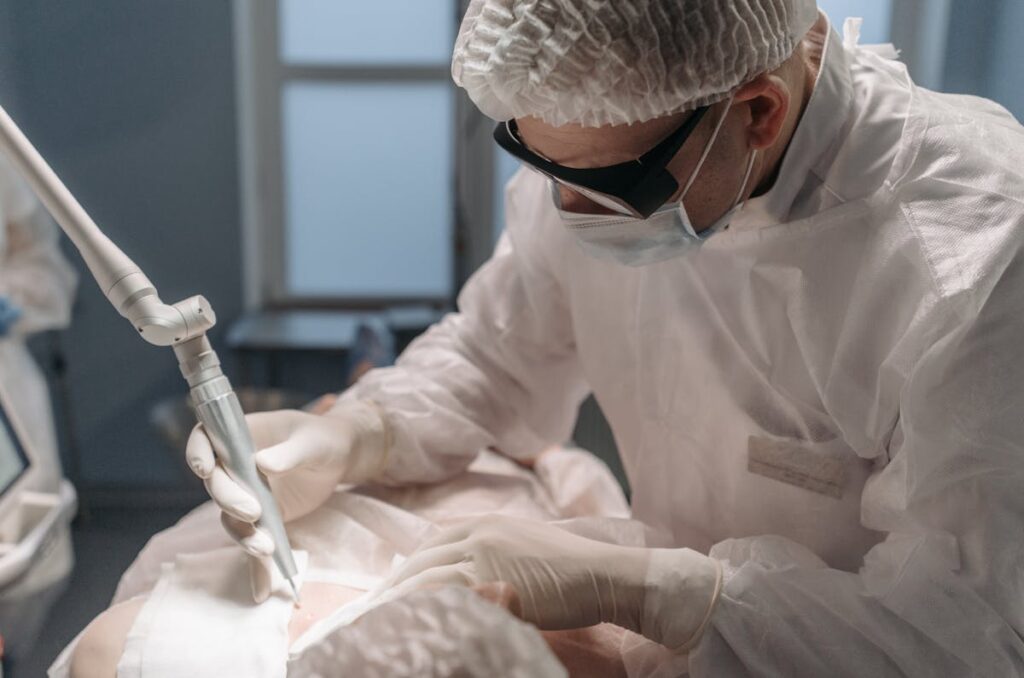Laser spine surgery is a modern and minimally invasive way to treat chronic back pain. Using precise laser technology, doctors can fix problems like herniated discs or spinal stenosis, causing less harm to nearby tissues. This means less pain after surgery, quicker recovery, and fewer risks compared to traditional surgeries.
Understanding how laser spine surgery works can change how we think about managing ongoing back pain. This innovative procedure offers a new approach to pain relief by targeting specific spinal issues. With laser precision, recovery is faster, and complications are minimized. If you have chronic back pain, laser spine surgery might be an option worth exploring.
Understanding Chronic Back Pain
Chronic back pain means having back pain that lasts more than 12 weeks. It often comes from issues like degenerative disc disease, herniated discs, or spinal stenosis. These are not diseases themselves but signs of problems in the spine’s structure. Lifestyle habits can make chronic back pain stick around. Sitting too much, being overweight, and not sitting or standing correctly put extra strain on your back. Stress and smoking can also make pain feel worse and slow down healing. Age and genetics play a role too. Understanding these causes is key to finding better treatments.
Traditional Treatment Methods and Their Limitations
Dealing with chronic back pain can be challenging. Traditional methods like physical therapy, pain medications, and surgery each have their own drawbacks. Physical therapy can take a long time to show results and may not always work as hoped. Pain medications might cause dependency and side effects without solving the root problem. Surgery can be risky, with chances of infection and long recovery times, and it might not always relieve pain effectively. That’s why exploring options like laser spine surgery could be worth considering. By understanding these choices, you can make more informed decisions about managing back pain.
Limitations of Physical Therapy
Physical therapy is a key tool for managing chronic back pain, but it has its limits. If you have severe spinal issues or ongoing nerve problems, physical therapy might not provide enough relief. People with conditions like advanced degenerative disc disease or spinal stenosis might find it hard to fully participate in therapy sessions. In these situations, physical therapy may not significantly ease symptoms or improve life quality. For such cases, treatments like laser spine surgery might be the next step to effectively tackle the root cause and bring real pain relief.
Drawbacks of Pain Medications
Pain medications, like opioids and NSAIDs, are often used to help people with severe chronic back pain. Opioids can be very effective in reducing pain but come with the risk of addiction, making long-term use tricky. NSAIDs, while helpful, can lead to issues like stomach bleeding and heart problems if used for a long time. Because of these side effects, doctors need to prescribe them carefully and keep a close eye on patients. This shows why it’s important to look for other treatment options that might be safer and easier on the body for managing chronic pain.
Risks of Traditional Surgery
Why do people sometimes hesitate to choose traditional back surgery? Traditional back surgery can result in complications and long recovery times. Common problems include infections, nerve damage, and blood loss, which can worsen a patient’s condition. Large incisions in these surgeries also increase the risk of infections after the operation. The long recovery period often means extensive rehab and limited movement, affecting daily life. These factors can make patients feel hesitant and unsatisfied after surgery. Furthermore, traditional surgeries might not fix the root cause of pain, leading to ongoing discomfort and possibly needing more treatments.
What Is Laser Spine Surgery?
Laser spine surgery is a modern and less invasive way to help with chronic back pain. It uses focused laser energy to treat specific spine issues. This type of surgery can make procedures like disc decompression and foraminotomy more precise. Types of laser spine surgery include laser discectomy and laser-assisted endoscopic spinal surgery, each targeting different spine problems. The precision of lasers means less damage to nearby tissues compared to traditional methods. Benefits include less pain after surgery, quicker recovery, and a lower chance of infection. These advantages make laser spine surgery a popular choice today.
How Laser Spine Surgery Differs From Conventional Surgery
Laser spine surgery is different from traditional surgery because it uses a laser to treat the spine. This method is less invasive, meaning it usually leads to quicker recovery. Traditional surgery often involves bigger cuts and more handling of muscles and tissues, which can mean longer healing times. Laser spine surgery often uses local anesthesia, which is safer and helps patients get moving faster after the procedure. The laser’s precision allows doctors to target problem areas in the spine directly, reducing damage to surrounding areas and helping patients with chronic back pain recover more quickly.
The Benefits of Laser Spine Surgery
Laser spine surgery offers several benefits for those considering treatment for back pain. Its minimally invasive nature means smaller cuts, which results in less harm to nearby tissues and less pain after surgery. People who opt for laser spine surgery often heal faster than those who have traditional open spine surgery. This quicker recovery means shorter hospital stays, allowing patients to get back to their normal activities sooner. The risk of infection and bleeding is also lower, making it a safer choice. Laser technology targets specific spinal issues, leading to better surgical results. For those suffering from chronic back pain, laser spine surgery can be an effective option.
Conditions Treated by Laser Spine Surgery
Laser spine surgery means treating spinal conditions with precision using advanced laser technology. This minimally invasive method helps with issues like herniated discs, spinal stenosis, and degenerative disc disease. By using spinal decompression, it reduces pressure on the spinal cord and nerves, which results in less pain and better movement.
Studies show laser-assisted procedures often have shorter surgery times and less tissue damage than traditional surgeries. The precision of lasers targets only problematic areas, minimizing damage elsewhere. This approach supports quicker recovery and lowers risks of infection and complications, making it increasingly popular in medical settings.

The Laser Spine Surgery Procedure: What to Expect
Laser spine surgery is a modern way to treat spinal issues with lasers. This method uses a small cut, usually less than an inch, which means less disruption to your body. It’s great for conditions like herniated discs or spinal stenosis. The surgery takes about 60 to 90 minutes, depending on the problem. Lasers help remove or shrink tissue that’s causing pain by pressing on spinal nerves. Compared to traditional back surgeries, this method usually means less pain after surgery, smaller scars, and a quicker recovery.
Recovery and Rehabilitation After Laser Spine Surgery
Recovering after laser spine surgery involves taking good care of yourself and following a specific physical therapy plan. Moving around early and doing specific exercises can really help you get better faster and avoid problems after surgery. It’s important for healthcare providers to create a recovery plan that fits your needs. This plan should help you stay active without putting too much stress on your healing back. By sticking to this plan, you can improve your recovery and get back to your daily activities more quickly.
Post-Surgery Care Essentials
After laser spine surgery, proper care is key to recovery and long-term success. Focus on diet and pain management. Eating a balanced diet helps repair tissues and boost the immune system. Include plenty of protein, vitamins, and minerals in your meals. For pain management, doctors usually recommend a mix of medications like NSAIDs and muscle relaxants. Keep track of your pain levels to adjust meds safely and stay comfortable. Following your doctor’s advice on activities is crucial too. This helps protect the surgery area and speeds up healing. Stick to these guidelines to avoid complications and heal better.
Physical Therapy Guidelines
Physical therapy helps you recover after laser spine surgery. It focuses on creating a personalized exercise plan that fits your needs, improving your recovery and reducing complications. These programs include exercises for strength, flexibility, and endurance, aiming to make your spine stable and improve overall physical health.
Your plan will consider how your surgery went, any existing health issues, and your personal goals. Activities that involve gradually increasing weight and balance training are key to retraining your muscles and maintaining long-term spine health. Regular monitoring and adjustments ensure you stay on track, enhancing your quality of life and independence after surgery.
Is Laser Spine Surgery Right for You?
Laser spine surgery might be a good option if you have issues like herniated discs, spinal stenosis, or degenerative disc disease, and other treatments haven’t worked. To decide if it’s right for you, a spine specialist will check your medical history, imaging results, and symptoms. The best candidates usually have fewer health problems and specific spine issues. If your pain is widespread or your spine has major abnormalities, this surgery might not be the best choice. Consulting with both neurosurgeons and orthopedic specialists can help create the best treatment plan for your situation.
Frequently Asked Questions
How Much Does Laser Spine Surgery Typically Cost?
Laser spine surgery typically costs between $10,000 and $50,000. Insurance may cover part of the expense, but out-of-pocket payments are often necessary. To manage costs, patients can look into medical loans or installment plans, which may make the procedure more affordable. It’s essential to check with your insurance provider and explore all payment options to find what works best for your situation.
Are There Any Risks Associated With Laser Spine Surgery?
Laser spine surgery can come with risks like nerve damage, infection, or bleeding. Each person heals differently, but most see improvement in a few weeks. How well you recover depends on your health and following your doctor’s advice after the surgery.
If you’re wondering about laser spine surgery risks, they include nerve damage and infection. Your recovery might be quick—often just weeks—if you stay healthy and follow post-surgery care tips. Always talk to your doctor about any concerns to ensure you’re making the best decision for your health.
How Can I Find a Qualified Laser Spine Surgeon?
To find a qualified laser spine surgeon, start by checking their board certification and specialized training. These credentials mean the surgeon has met specific standards and has expertise in laser spine surgery.
Next, look for patient reviews. Reading testimonials from others can give you a sense of the surgeon’s reputation and the results of their treatments. This helps you make an informed choice based on real experiences.
Will Insurance Cover the Cost of Laser Spine Surgery?
Does Insurance Cover Laser Spine Surgery?
Insurance coverage for laser spine surgery varies based on your specific policy. It’s important to check with your insurance provider to see if you’re eligible. Often, laser spine surgery is considered elective, which can affect both the reimbursement from insurance and your out-of-pocket expenses. Call your insurance company to get clear details about what your plan covers. This way, you can plan your budget and avoid unexpected costs. Always make sure to have this conversation ahead of time to understand what financial responsibilities you might face.
How Long Does a Laser Spine Surgery Procedure Take?
Laser spine surgery usually takes 45 minutes to an hour. This quick procedure often results in less pain after surgery, allowing many patients to get back to their usual activities within a few weeks. Recovery times can vary based on individual health conditions.
